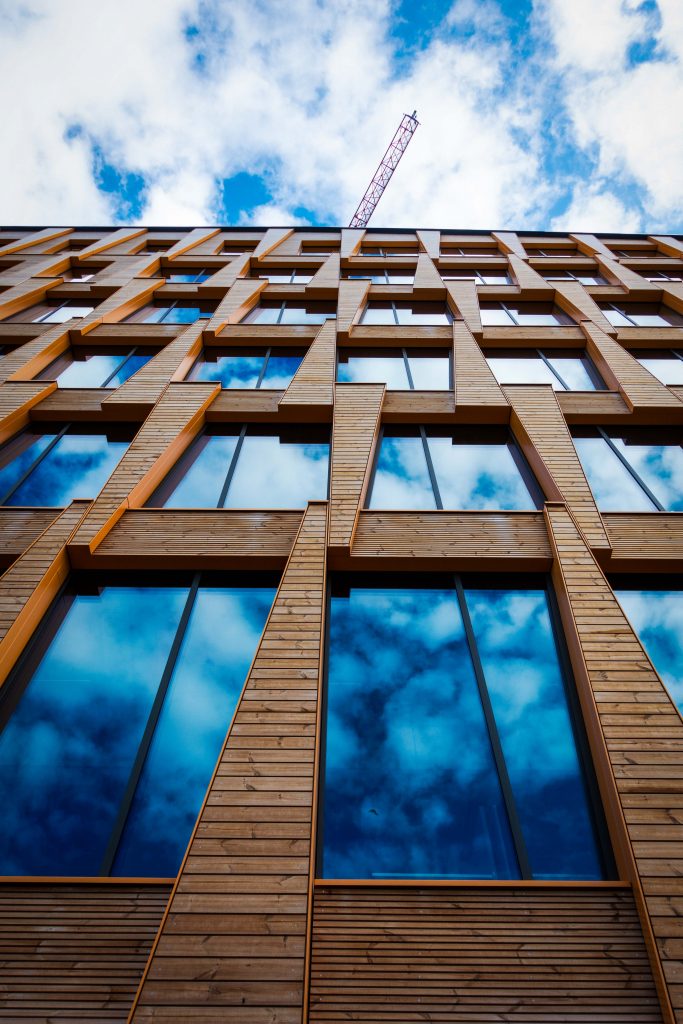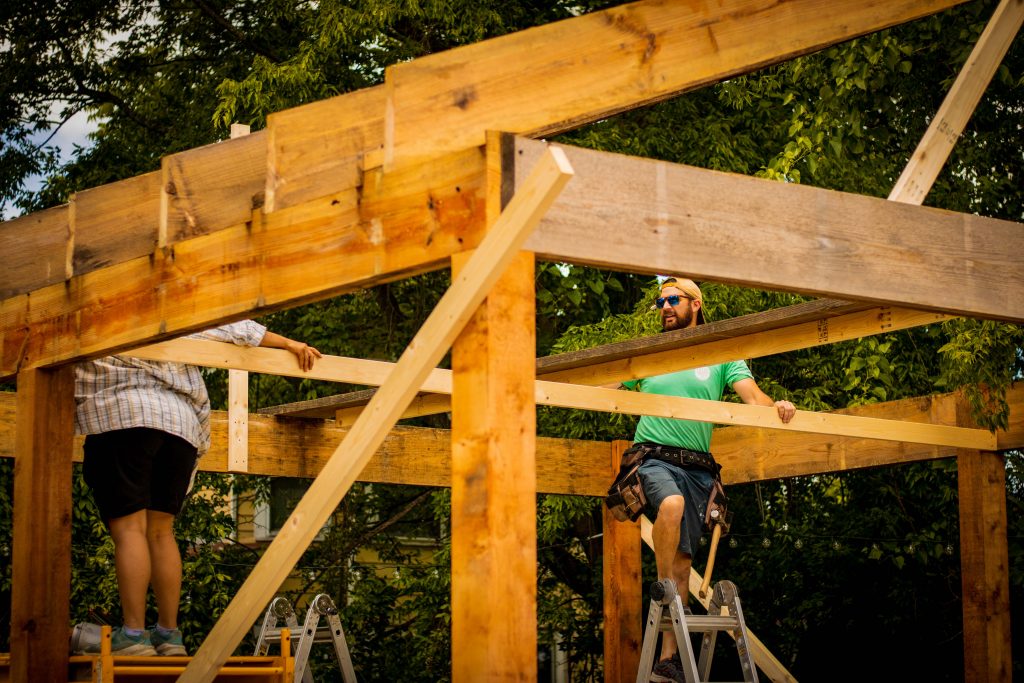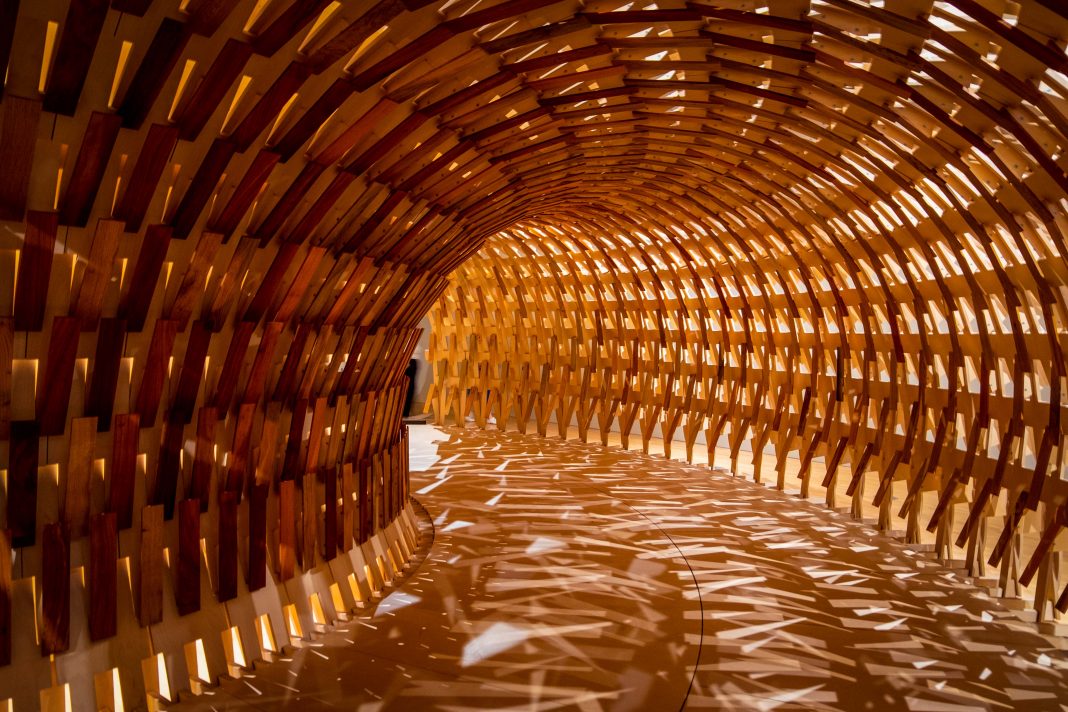A house made of straw, an office block made of timber, or a shopping centre made with hempcrete – you might be thinking that this all sounds very hippyish, but this could be the vision of a sustainable future that the world desperately needs. We spoke to Janna Laan Lomas, founder of Grain Architecture and the Natural Materials Group within Architects! Climate Action Network (ACAN) to find out why natural materials could be the answer to several of our worries.
The buildings and construction industry are responsible for using up 50% of raw materials and for 40% of energy consumption globally. If you look at the modern buildings around you, you can bet your bottom dollar that every single one will have been constructed using at least some cement, concrete, and/or plastic. It’s no wonder that the industry is contributing to climate change and burdening the environment. But is our dependence on these materials actually necessary? Janna Laan Lomas gives a firm “no”, citing numerous alternative natural materials during our conversation.
What Are Natural Materials?
Just to be clear, by natural materials here we mean using substances found in the natural world, which can be used either directly or after minimal processing for a particular construction purpose, such as boards for inside or outside walls, the structural frame, insulation material and flooring, among others.
Together with Janna, we’re going to show you exactly why should you go that extra mile to use plant-based alternatives, how you can get started, and how you can tackle some of the challenges that might pop up along the way.
Reaping the Rewards
When asked about the benefits of using natural materials, Janna starts by saying, “there are so many positives, I could talk about it for hours!”. And she’s not wrong. We’ve broken them down into four main categories:
1. Ecological
Naturally the first advantage of these substances is that they have a significantly lower carbon footprint than conventional alternatives, primarily because they require less processing. “By definition, they are closer to their natural state”, Janna explains. She continues by saying less energy is used to make them and, as an added bonus, plant-based materials also sequester carbon, i.e., they absorb CO2 and store it for their lifespan.
“Just through choosing and using the right materials, then we can actually work in really positive systems that help restore soils and improve biodiversity.”
2. Resources
“Concrete is not a cyclical material, it is a finite thing”, Janna says, implying that we are using far too much of non-renewable resources in ways that are single use. Given that we are facing a climate and ecological crisis, “using more sustainable, continuously renewable sources of materials – going for more natural materials – that you can use in a cradle-to-cradle cycle” is a critical part of resource management. We need to consider what happens to the materials once they can no longer be used for a particular purpose anymore. For something to be cyclical, we need be able to return it to its original state, reuse, or recycle it.
3. Human Health
This aspect is two-fold: it benefits those working with the materials and those then living or working in the buildings once they are complete. Using natural building materials generally means you’re creating a non-toxic, vapour-open environment with improved air quality. Our expert explains that, through natural substances, moisture and humidity can self-regulate, leading to less damp and mould and therefore contributing to healthier air.
4. Economical
Not only do we mean in terms of saving the pennies in our pockets, but also saving on resources; if moisture isn’t trapped in the building, it can be maintained well. Plus, “buildings that are breathable can last an incredibly long time”, Janna states.
Getting Started: How Can I Build Sustainably?
First things first; knowing what building sustainably actually means. For Janna, it’s thinking holistically about how the building interacts with the natural ecosystem, the whole lifecycle of the materials, the building performance and the impact on the wider environment. Another critical part of sustainable development is considering regenerative land management (restoring the soil and biodiversity), material sourcing, and “the true circularity of materials”.
“In a time of crisis, I would class using any material that you don’t NEED, as unsustainable.”
1. Eliminating the Two Main Culprits: Concrete and Plastic

There aren’t just two culprits, but concrete and plastic tend to be the biggest offenders in the construction world. Not using them, or using them sparingly, is one of the most significant steps and best changes that every construction site, architect, engineer, and urban planner could make.
Despite the fact that concrete is the second most consumed substance on the planet, after water, Janna explicitly tells us that this is completely unfounded. Particularly for small-scale construction, there is often absolutely no need for concrete. In her opinion and in her practice at Grain Architecture, “concrete is the last resort, rather than the first option”. She is of the opinion that changing the first option is the main difference that we’ve got to make. In fact, if you consider the benefits of the natural materials that we talked about above, in comparison, concrete performs worse than, well, all of them!
Concrete and plastic may have their place and can be extremely useful in some instances, but “the fact that we use concrete and plastic to the extent that we do, at the scale and quantity that we do, that’s what is worrying”, says Janna. Just imagine that the global building industry pours enough concrete in a day to cover China’s Three Gorges Dam; that’s enough to cover the whole of England every year.
And it’s a similar story with plastic. We’re told that there has been a real trend recently to basically fill and wrap everything, entire buildings essentially, in plastic. i.e insulation and membranes. But really, “we should try and avoid plastics as much as possible”. When building, you really need to think about air tightness and breathability (we’ll look at this later). By using the right materials and building with them cleverly, there will actually be very little need for plastic. Our expert gives us the following example: instead of a plastic-based insulation, choose a natural insulation, and instead of automatically adding membranes, building elements can remain vapour-open, and joints (often the weak spots in terms of air tightness) can be taped. You could even use materials with a tongue and groove edge so that they fit together nice and snuggly.
“High-energy materials are the vitamins of a building – they are needed in small and precise quantities – but the main part of your diet is made up of plant-based natural products.”
When working in construction and architecture, you may be challenged by contractors or clients about using plastic or concrete and, yes, sometimes it is unavoidable. However, you must be open-minded, prepared, and knowledgeable enough to be able to design out plastic. i.e., come up with an alternative solution.
2. Dealing with the Elements
It goes without saying that a building should protect its occupants from the elements, particularly: water, air, wind, and fire. That all starts with the materials you use and how you utilise them. The top tips from Janna: “You need to understand how moisture will move and how you want it to move through a wall, floor, or ceiling.” Taking humidity and moisture into account is crucial to designing a long-lasting, durable building as well as one that will be optimal for the occupants’ health.
Many building products are now being advertised as being able to last 30-50 years, as if this is some kind of amazing feat and something we should praise. But in the lifetime of a building, that’s actually not very long – the building should easily be able to outlive a human.
Essentially, in order to achieve optimum longevity of a building and, in turn, avoid the unnecessary need to build a new one after a short period, we need to be thinking about humidity, moisture, and the breathability of our construction materials. Which may not be that difficult if you…
3. Make the Switch to Timber
“If someone is a designer in a practice where they commonly use concrete or steel, they could immediately switch to timber construction as their first choice.”
This is another top tip from Janna, and it, she says, is not a surprising nor outrageous suggestion. Timber has been used for a very long time and is very versatile; you can have a timber frame, it can be used for wall, roof and floor construction, as well as for insulation and for finishes.

Timber construction and insulation have proven to perform just as well, if not better than conventional materials. Typically, modern buildings are made of brick and concrete block with a small cavity and a thin plastic-based insulation. But with a timber frame, all of the space that is taken up by the concrete blocks can be used for insulation. This means you can have better performance for the same wall thickness. Many argue that natural insulators behave worse than manmade materials and therefore require thicker walls, but Janna states that this is part of the myth busting that needs to happen.
And, as if by magic, she pulls out a piece of rigid wood fibre board to show us – yet another use of this wonder material. Janna praises the wood fibre-based insulations available – either board that can be wrapped around the outside of the building or the flexible options, similar to wool, which can be placed between timbers. This provides a really solid system of insulation and maintains breathability. Wood fibre board is made sustainably from waste or low-grade timber, and if demand continues to grow then the industry can expand to enable it to be more locally produced.
4. And There’s More!
Timber isn’t the only natural building resource out there, as Janna soon tells us. She mentions constructing out of straw bales, for example. “We could be building super-insulated homes with a cheap waste material that can achieve really high standards, even Passivhaus standards”, Janna explains.

And there’s other good news too – “it’s not rocket science”, she says. Many self-builders (people building their own homes) choose straw bales because there aren’t multiple layers to work with, and they can be put up very quickly. Importantly, although straw buildings may often be associated with a rural setting, she emphasizes that there is no reason why it couldn’t happen in an urban environment.
Janna also mentions hempcrete and earth blocks or adobe, which is a very common construction material in a lot of the world. Take a look at our guide to natural construction materials here for more information and other alternatives.
We also spoke to Janna about using recycled materials in construction; in other words, building something out of waste that has been turned into a new resource. She warns that you should always be wary in this area as these materials may not actually be the healthiest option, lacking breathability or even containing toxins – something we’re trying to avoid by not using some conventional building materials either.
However, there are some other great examples, such as high-quality insulation made out of recycled cotton from old blue jeans. Janna praises the material for not only being non-toxic, natural, and breathable, but it also performs really well as an insulator and is made from a massive waste stream.
5. Closing the Loop – Lifecycle Analysis
Interestingly, Janna says that her practice is only now starting to do lifecycle analyses; previously they simply aimed to do things as naturally and as sustainably as possible, while building “for either deconstruction or compostability from day one”. Despite this, they are now crunching the numbers to have the facts and figures and carbon footprint calculations on hand to back up the work they’re doing.
She says this all comes down to circularity and needing to consider what is happening with the materials and with the building from the very first to the very last step. In order to be truly sustainable, we need to close the loop and ensure that there is a life for these materials once the building is no longer used in its current state. Doing a thorough lifecycle analysis could quite literally be a lifesaver for us and those materials.
“If we are to reduce and eventually reverse the environmental damage we are causing, we will need to re-imagine our buildings, cities, and infrastructures as indivisible components of a larger, constantly regenerating and self-sustaining system”.
Construction Declares

5 Key Take-Aways
- There are myriad of benefits to natural materials that far outweigh the slightly higher cost at the outset.
- Avoid concrete and plastic at all costs – high energy materials should be a tiny proportion of your building, while plant-based resources should be the majority.
- Check out all your options – there are multiple ways of building sustainably with a variety of materials on offer, so be sure to consider them all before making your decision.
- Circularity is key – do your lifecycle analysis, think about what will happen next to these materials, connect all the dots, join all the systems, and make sure you know how what you are doing could impact the wider environment.
- It is possible and the setbacks can be overcome – from dealing with false assumptions, to unhelpful building regulations, to builders adding contingency to the bill – it’s all about information. Find out more here.
Janna’s Advice for CityChangers
- Dig deep – there are plenty of resources out there, you’ve just got to hunt them down. Once you find the information you’re looking for, the outcome really will be worth it.
- “Take responsibility, educate everybody in your team and really try and encourage better building”, Janna says. Play your part in protecting the planet and don’t shift the responsibility onto someone else’s shoulders. Just get stuck in.
You’ve heard from the expert – sustainable construction is possible; you’ve just got to take that leap. Now, why not find out what you need to bear in mind when starting construction with natural materials here or take a look at our article exploring the variety of natural materials out there.
For even more information about the different natural materials why not jump right to their fact files:


